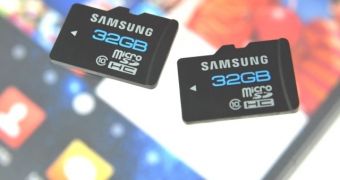Even as it releases one new product and update after another, Samsung invested enough time, effort and resources into creating a memory card aimed at fourth generation smartphones.
Samsung has been releasing hardware products and consumer electronics for quite a while now, so it has an established portfolio.
One facet of said portfolio is composed of NAND Flash-based storage solutions, especially memory cards.
In fact, a memory card is exactly what the outfit created most recently, one of the micro Secure Digital (microSD) variety.
With a capacity of 32 GB, it is composed of 3-bit NAND chips of 32 Gb each, as well as a 3-bit NAND controller.
Said controller, leveraging the assets of the 20nm manufacturing process technology, is able to reach read and write speeds of 24 MB/s and 23 MB/s, respectively.
In other words, they bear the class 10 performance rating and, though not at IBM's new standards, it should do well in even storage and transmission of Full HD video files.
This last capabilities is quite relevant considering that fourth-generation (4G) smartphones, which the card is intended for, have this as one of their increasingly more popular features.
“The industry demand for high-class-rated memory cards addresses the growing performance push for next generation mobile applications in more advanced smartphones including 4G models,” said Wanhoon Hong, executive vice president, memory sales & marketing, Samsung Electronics.
”As the industry adopts microSD cards with a class 10 rating, the superior data transfer speeds are expected to improve the mobile user experience tremendously.”
A side-effect of using the 20nm process instead of the 32nm one is a productivity boost of more than 30%. Mass production should start soon, if it hasn't already.
Meanwhile, the outfit is already designing 64 Gb 20nm-based NAND Flash memory, but this new product will only enter the mass production stage early next year (2012).

 14 DAY TRIAL //
14 DAY TRIAL //